I could have stayed on Havelock Island for months. I would have. But my wonderful new group of friends started to leave, so I needed a new place to go. Of course, I had no plan.
After a few of my favorite people left the island, I spent my remaining afternoons talking out my internal dilemma to the remaining Swedes: should I venture north in the Andamans to see something new of the islands? Could my time be better spent in mainland India? Where in mainland India should I go, if I went? Could someone just decide for me?
I had gotten lazy and indecisive (and happy). My backpack hadn’t been packed or lugged for 17 days in Havelock. I had a fantastic Holi Festival there as well. My beach hut had become home in no uncertain terms.

The view from room 42. My Havelock home!
But it was time to go – as good as it might have been to stay, there were so many other things I had yet to see! I took a rickshaw ride to the jetty several times to weigh transit options.
Via trial and error, I learned a few important things about booking ferry fares from Havelock:
- Buy your ferry tickets a few days in advance. You stand a good chance of not getting on the boat you desire even with what seems like an ample two days of lead time – so be decisive and buy a prospective fare when you find yourself at the ticket office even if you aren’t certain you want it. This seems like being inflexible, but it’s not – If your plans change, you can either try to refund your existing ticket or you can just eat the cost of the 250 Rupees (or such). It’s just five bucks after all! Plus, rickshaw rides aren’t free, and by the time you’ve come and gone from the jetty office twice, you might as well have bought a ferry ticket in the first place.
- Weekends are bad for ticketing. In Havelock, the government ferry office takes a half-day on Saturday (show up at opening time if you expect to get anything done) and the office is closed Sundays. Throw in some other government holidays that the traveler wouldn’t know about (or who knows, a labor dispute, etc) and you could easily get your departure date pushed back by two to four days.
- There’s a backup option if you need to get back to Port Blair. A company called Makruzz operates a private “fast” “luxury” ferry that runs between Havelock and Port Blair. At the time of this post, Makruzz is running ferries from Port Blair to Havelock at 8:30 AM daily, and from Havelock to Port Blair at 4:00 PM (also daily). Makruzz is the also the “expensive” ferry – expect 700 Rupees plus per fare. Makruzz’s ticket office is located next to the Havelock jetty and is open on weekends, but be warned: if you come in the middle of the day, they may be on one of their long, service-less lunches.

tough decisions at the ticket office. Riley in Havelock.
I couldn’t make up my mind on what to do, and the ferry offices were threatening to close / break for two hour lunches, so I bought a redundant two ferry tickets to cover my bases:
Ticket #1: 250 Rupee fare on the government ferry to Rangat, for onward ground transit to North Andaman and continued tourism in a new, less-touristed part of the Andamans.
Ticket #2: 700 Rupee fare via Makruzz to Port Blair for onward air transit to mainland India, in order to continue traveling with a friend I met on Havelock.
I wanted BOTH of these things – more Andaman adventures, but also to see my friend in Delhi. How could I have them BOTH and give NOTHING up?
There wasn’t a lot of information available from other travelers nor from the Lonely Planet about travel in the northern parts of the Andaman Islands. Most backpackers weren’t headed that way, and even locals on Havelock responded to my “I am planning to visit Diglipur-slash-Kalipur of North Andaman” with raised eyebrows. I needed more information to execute.
After almost giving up hope for a quick and dirty visit to North Andaman, the proprietor of Anju Coco Resto, a favorite dining spot, gave me some good advice after no one else could:
“Go north – you don’t have to spend much time – just a day in this place, one day there. Take the ferry to Rangat, a bus will meet you at the jetty to take you to Diglipur. If ferry is late, bus waits. Here <points at map of North Andaman> sea turtles are nesting, here <points> very beautiful beaches, here <points> there are wild elephants….” etc etc etc
I could get in and out in five to seven days, all in, without too many headaches or body-destroying transit days? Ok, that’s doable. Let’s go!

The Andaman Islands. For reference: the towns of Rangat and Diglipur are to the middle and top, respectively, and are labeled in yellow and touch the dotted-line of the government ferry. Click for a bigger view.
I boarded the March 19th, 10:00 AM ferry to Rangat (my 250 Rupee government ferry fare) and tossed my 700 Rupee non-refundable Makruzz ticket to Port Blair.
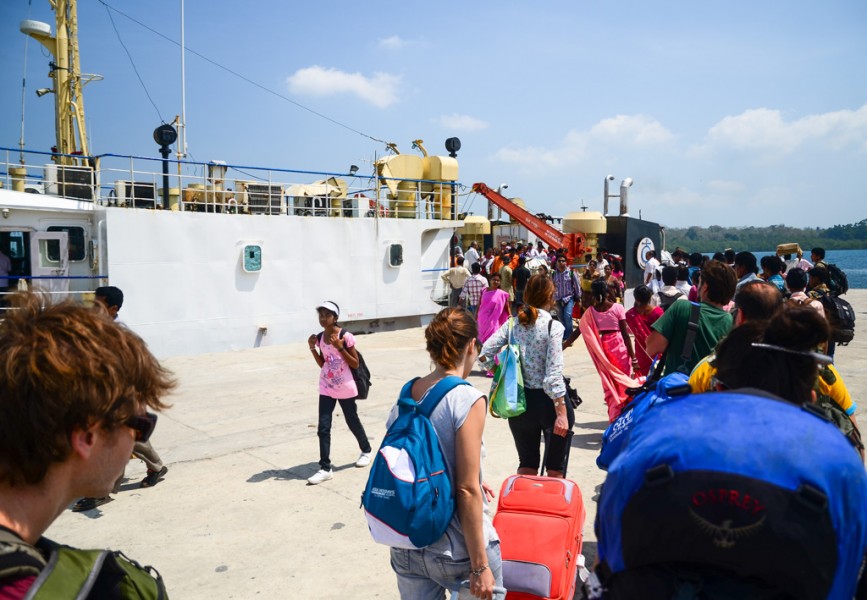
Boarding the ferry. Havelock -> Rangat.
The trip to Rangat went past Long Island, a somewhat primitive beach destination (“like going 300 years back”) and took something like four hours total (if I remember correctly). Almost all the travelers got off the ferry at Long Island.
Upon arrival in the backwater transit town of Rangat, I noted a total of two backpackers still on the ferry other than myself. Alone (but not lonely!), I magnetized to them and struck up a conversation.
Where were they going? The town of Kalipur, via Diglipur. Where was I going? Same. Meet your new travel buddies – Bernard and Naella, of Quebec! It’s just that easy.

Naella, of Bernard and Naella.
What wasn’t as immediately easy: figuring out how to get to Diglipur/Kalipur. The bus that “always waits for the ferry” was nowhere to be seen, despite assurances that it would be. No bus. I asked a few locals that weren’t profiting from transit. No bus still. Ok, so there’s really no bus. What now?
A few jeeps were lined up along the jetty, and in usual driver fashion, were trying to get us to quickly make a deal with them for passage in a “LIMITED TIME OFFER!” fashion.
When boarding a privately hired vehicle (rickshaw, jeep, etc), control the tempo of negotiations, and you exercise a greater degree of control over the price and terms of your agreement. If your potential driver is pushy and/or impatient, walk away and watch the price drop. If it doesn’t, there’ll be another vehicle around the bend. The only time this may not work is for early morning runs to the airport/train station, in which booking ahead at the going rate may be the only way.
There was (seemingly) only one jeep going our way from Rangat, but we bargained like there were a million options. We got the price to the still-too-high-but-our-only-option price of 200 Rupees per person and set off north in our jeep to Mayabunder, the halfway point en route to Diglipur.
The roads leading north from Rangat were in much better condition than I could have expected – many were well sealed and traffic was light. Small logging camps and miniature, typical Indian villages dotted the left side of the road as we drove north with the coast to our right. A few of the bridges we crossed may have led to some quiet holding-of-breath, but not for me – didn’t you know that I’m incredibly brave by now?
Mayabunder finally came, and came along with a three hour wait for the bus. We ate a 40 Rupee thali at a nameless restaurant along the single road through town and killed some time. There were no other tourists in town. The local kids looked more Burmese than Indian and found the three western backpackers eating with their right hands pretty amusing. They whispered and curiously leered as if we could understand their chatter, but didn’t feel their stares. We’re aware that you think we’re weird!

Ok, maybe a little weird. Self-portrait in Kalipur.
The bus to Diglipur arrived and we crammed on in the usual fashion, backpacks inconveniently sitting upright in the aisle. The locals are so used to cargo in the walking/standing space that there’s no need for apology – they’ll climb over your bags and boxes like they always do in their crowded country.
I forced my 65 liter pack into the available space and sat down next to a man from Kerala, by way of Bangalore, working in (surprise), IT.
If you meet someone from Bangalore, they work in IT. Ok, fine – 99% chance, just to allow for a margin of error.
He was ready to really talklike few Indians had been on my trip thus far. I had spent innumerable bus and train rides just explaining why I wasn’t married and being told why I should get married, and I was getting sick of it, no matter how friendly the tone had been from my marriage counselor come lately.
I’M NOT MARRIED. CAN WE TALK ABOUT SOMETHING ELSE, PLEASE?
This guy was ready to really share information, and to listen, too! I wasn’t used to it. Here’s what I took away from our time together:
- He thinks “living gods” like the “Hugging Mother” Amma and (the late) Osho are more or less farces, but not as much of jokes as the westerners that willingly throw themselves (and their money) at these people’s feet. Agreed!
- He explained why communism had come to the state of Kerala: it was a reaction to the caste system. What better way to clean house of caste than to make it law that all things are equal? Yes, perhaps this could have been done with a democratic government, but the communist route may have been more forceful and succinct.
- His number one problem with India? Corruption. And until it ends or is substantially reduced, nothing else can be fixed.
Thanks, guy-whose-name-I-can’t-remember, for making the last few hours of a 12-hour transit day so interesting! If only all my conversations with Indians, regarding India, had been so involved and thoughtful. In honesty, I found many Indians either impenetrable insofar as discussing India was concerned. Not so this night.
I disembarked into the small town of Diglipur around 9:00 PM and reunited with fellow travelers and Québécois Bernard and Naella who had been sitting at the back of the bus. We hailed a rickshaw and took a 30-minute ride to our final destination for the day, Kalipur.
So how does one get from Havelock to Kalipur in one day (god forbid you get stuck in Rangat)? There are a couple of ways I’m aware of:
HOW I DID IT:
- Ride the government ferry from Havelock to Rangat
- Hire a jeep to Mayabunder
- Take the government bus from Mayabunder to Diglipur (ask locals for departure times, find the bus on the main road through town)
- If by day, ride the bus from Diglipur to Kalipur (ask locals for departure times, find the bus on the main road in town). If by night, hire a rickshaw.
A POTENTIALLY BETTER, CHEAPER, FASTER WAY OF DOING IT:
- Ride the government ferry from Havelock to Rangat
- If available, ride the mythological government bus directly from Rangat to Diglipur
- If by day, ride the bus from Diglipur to Kalipur (ask locals for departure times, find the bus on the main road in town). If by night, hire a rickshaw.
WHAT IF I WANT TO GO TO DIGLIPUR FROM PORT BLAIR?
- There’s a bus that goes directly from Port Blair that takes around 12 hours (and vice versa – you can get back to Port Blair this way as well). Ask about it at your hotel, they can probably book you a seat.
- Then go to Kalipur as above! Easy, right? Well, what it lacks in challenge, it makes up for in discomfort.
A POTENTIALLY BETTER, CHEAPER WAY OF GETTING BETWEEN PORT BLAIR AND DIGLIPUR/KALIPUR:
- Ride the overnight government ferry between Port Blair and Aerial Bay Jetty (between Diglipur and Kalipur). Friends did this and said it was painless. Book in advance so you don’t MISS THE BOAT! Hilarious!
We asked our rickshaw driver to take us to Kalipur thinking there would be more than one place to choose from. There were two, but it only looked like one was serviceable. What was worse, it looked nice from the outside. When we pulled up, it had all the trappings of a proper place to stay, not a backpacker-priced semi-dump. There goes the budget, we thought.
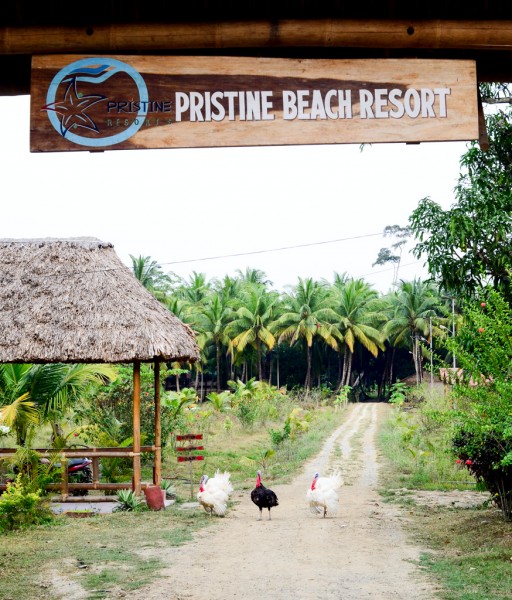
Pristine Beach Resort in Kalipur: guarded by noisy, puffed-up turkeys.
The place was almost completely empty though, so prices weren’t as high as expected. Come late April, the Death Valley of low seasons strikes the Andamans, and we were on the down slope.
My room was a reasonable 300 Rupees for a shack with mosquito net and fan and shared bathroom access. Bernard and Naella managed a much nicer ensuite room for 600 Rupees.

300 Rupees/night for a little fall-down shack surrounded by holes with sand crabs and frogs in them.
Within walking distance of Kalipur (or a short bus ride – take the bus if you can) is Saddle Peak, the highest point of elevation in the Andamans at 732m. Bernard, Naella and I agreed to climb the hill on our first full day in the Andamans, which Lonely Planet noted was a six hour trek, up and down. The kitchen at Pristine Beach Resort packed us some fruit, sandwiches and water, and we set off at 7:00 AM.
“Only two kilometers to Saddle Peak,” our host at Pristine had told us. “Have you climbed it?” I asked? “Oh no, no…” he said with a puzzled look,as if I’d asked him to eat his hat.
It was more like five kilometers to the gate of the national park in which Saddle Peak lay. We paid for park permits (normal in the Andamans) and kept moving. The path wrapped us around the side of the hill by the seashore for over an hour – it felt like we were never going to leave sea level.
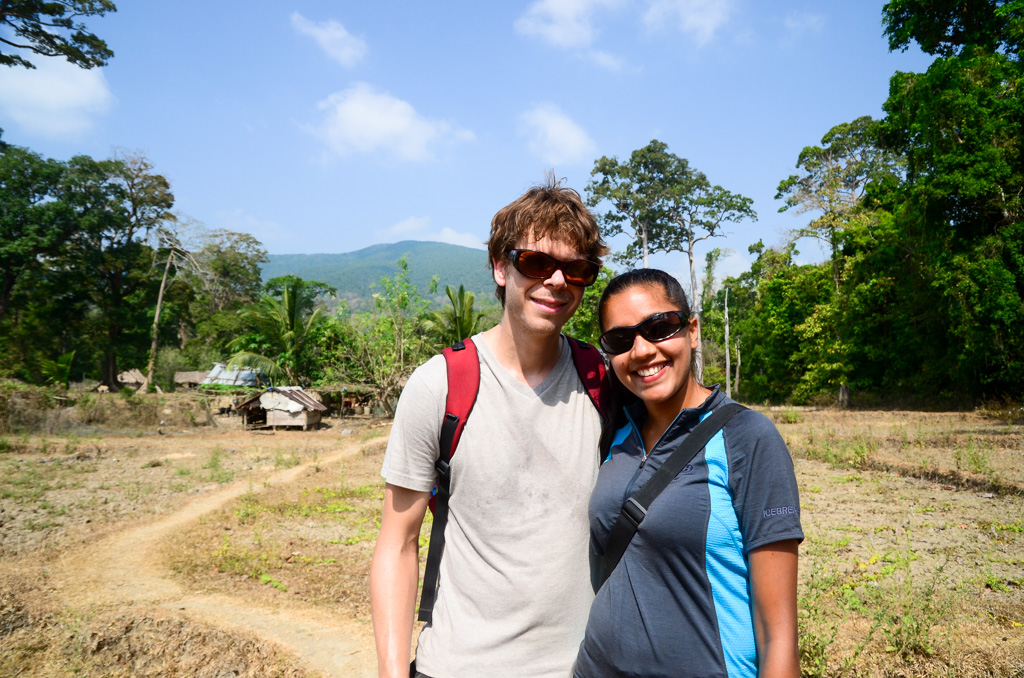
Bernard and Naella and Saddle Peak to the rear.
The path through the jungle was at times a bit confusing – we were supposed to follow red “arrows” painted on the sides of trees that had faded to almost nothing over the years. Should we have hired a guide? Oh well, keep moving.

Is this the path? (photo by Bernard)
Finally, the ascent started, and it wasn’t quite as easy of a slope as we had hoped. While it wasn’t a treacherous trail by any means, the path was angular and slippery with dry leaves. Oh, and we had only brought four liters of water between the three of us. Not enough! After several false summits (or what we were hoping would be the summit, anyway), we reached a clearing, probably around 650m up. The view of the surrounding archipelago was a hazy nothing that day. We snapped some forgettable pictures, and painfully admitted that none of us cared about going any higher. Back down we went.
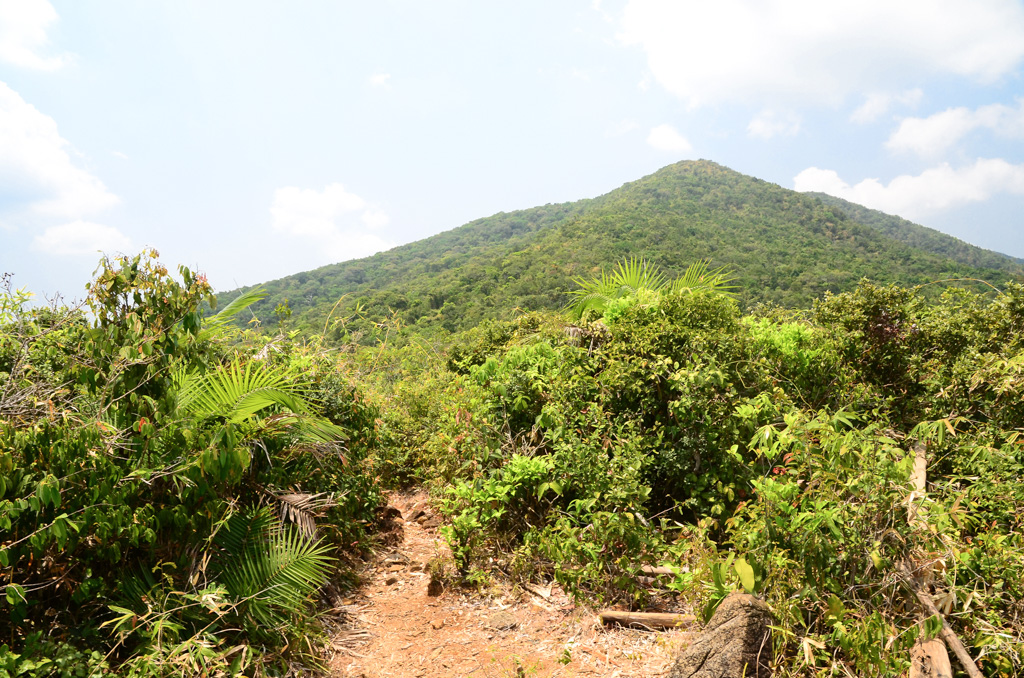
Saddle Peak – as high as we went.
Having run out of water halfway through the trek, and having seen almost no one else on the trail other than a local man collecting wood, it was probably a good idea to descend when we did. While this wasn’t a dangerous trek, no one would have come for at least 24 hours (maybe longer) if we had gotten injured. I would recommend taking a buddy along for a Saddle Peak trek.
We exited the park after about eight hours of trekking. Were we just in bad shape, or was Lonely Planet lying about the trek duration? Who cares – we were done. We arrived back at Pristine Beach Resort, where a nice surprise awaited, and crashed into our chairs for dinner.
The nice surprise? Two Swedish friends from Havelock had just arrived in Kalipur and had taken up residence at Pristine Beach Resort. Hurrah!
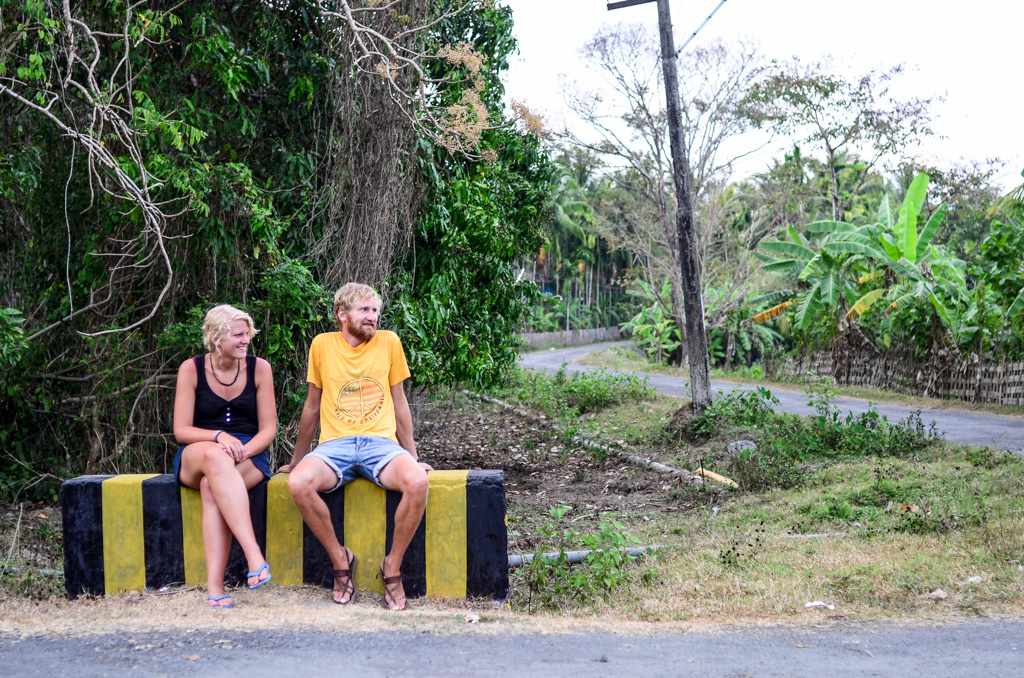
Sara and Christian, welcome to Kalipur!
It’s amazing how quickly one’s situation can change from complete solitude to being part of a whole gang of friends. Traveling alone is never really traveling alone!
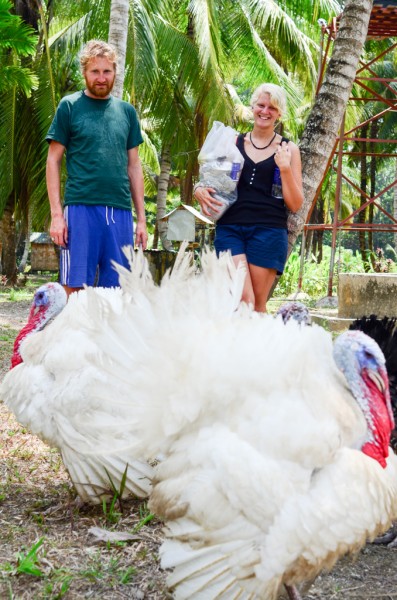
Never, ever alone in Kalipur thanks to the menagerie of random domesticated animals on Pristine Beach Resort. Not pictured: the doberman pinscher that lived at Pristine Beach Resort that liked to chase the turkeys around, which got him a routine scolding from “Uncle”.
I was asleep by 10:30 PM, and awakened again around midnight. Our host, “Uncle”, (an ex-cop that had found Jesus and always had a bible on hand, but never stopped talking about how much whiskey he used to drink and how many cigarettes he would puff while he swilled said whiskey) banged on my hut door and whispered through the woven walls that I should get out of bed. I thought it was some sort of emergency.
The emergency was that sea turtles were laying eggs on the adjacent beach. It’s the type of stuff that could bring a bride at a beach destination wedding to tears of joy. Me? I almost couldn’t pull myself off my pillow after my exhausting failed attempt at Saddle Peak.
Sara, Christian, Bernard, Naella and I walked up the path to the adjacent beach. I felt like I was hallucinating, and played what I felt was an appropriately psychedelic song on my iPhone speaker.
We saw two turtles. They awkwardly dug holes in the sand, deposited their eggs, and then flopped about to cover them back up. All the while, four Indian men spoke in loud tones in Hindi, hacked up phlegm and shined flashlights on the turtles. How touching!
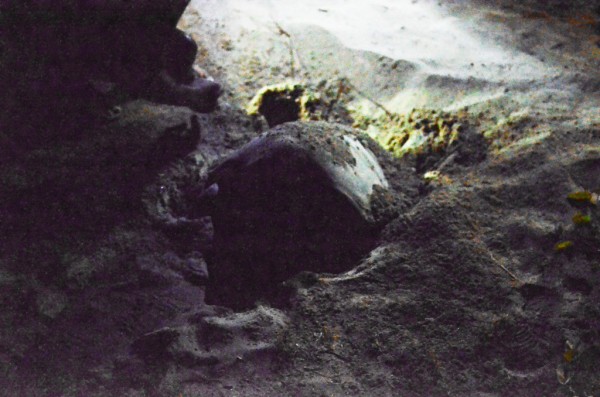
This horrible 6400 ISO picture is of an egg-laying sea turtle on a moonless night, lit by a pen light.
The loud Indian men let the turtle finish its business, then stabbed a pointed stick into the sand multiple times trying to find the cavity in which the eggs lay. Was this some sort of sand abortion? No, the eggs came out intact – over a hundred of them between the two turtles.
The eggs were whisked away to an incubator. Why can’t the eggs stay buried in the sand where mama turtle intended? Because stray dogs will dig them up. Just an idea: if the Andamans took steps to control their stray dog population, would any of this turtle-circus be necessary?
For my entire North Andaman trip, I had been suffering from a mystery illness. My lymph nodes were the size of bowling balls, my gums were bleeding openly, and my tongue looked like someone had put multiple cigars out on it. I couldn’t figure it out. As usual, the solution was to head to the pharmacy for some no-prescription-needed antibiotics.
Indian pharmacists don’t play the long game – they just give you whatever they see fit for each individual symptom that you tell them you have. It’s like trying to order a multiple-topping pizza, but ending up with multiple single-topping pizzas instead. I told my tale and walked away with a paper bag full of miscellaneous meds. And was I going to take them all? Hell yes, my mouth hurt like crazy, and at the moment, I didn’t have time or energy to worry about holistic, pro-biotic measures.
Even though it was painful to eat and talk, I was otherwise still fully functional. Thank god – there was much to do! First order of business: there was good snorkeling to be had just off Kalipur Beach, complete with an uninhabited island in swimming distance.
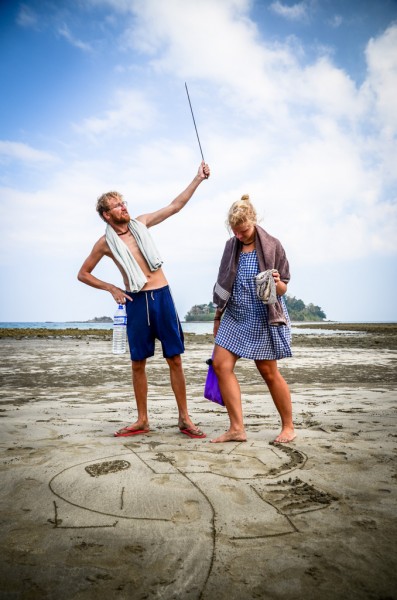
True Swedish Adventurers Sara and Christian, post-snorkeling on Kalipur Beach. Uninhabited island in background – it’s a longer swim than you think!
Sara, Christian and I got our snorkels and fins, and put a few books and lunch in a plastic zipper bag and dove in for the swim across. The bag instantly started leaking water, and my go across the channel took on a new athletic character as I balanced the heavy bag on my head while I swam. Soon enough, my Graham Greene novel was twice its weight, size and saltiness. Comical garden eels watched from the sea floor, disinterested in my struggle.

where we “hid” our valuables while snorkeling on Kalipur Beach.
The reefs were long with a nice variety of life, and the snorkeling was good. Christian brought a metal skewer/spear and attempted to bring in a lobster to grill, but ended up with only little ones that wouldn’t have been worth the effort. Bernard and Naella had a less positive experience – while they swam, their sandals and shirts were stolen off the deserted beach. It could have just as well been my camera and passport, which I trustingly left near the same area. Yikes.

Kalipur Beach tide pools.
We went on a salt-water crocodile hunt the following day. There had been much talk of beaches and mangroves crawling with these evil prehistoric-style monsters and we all wanted to get a good look at one.
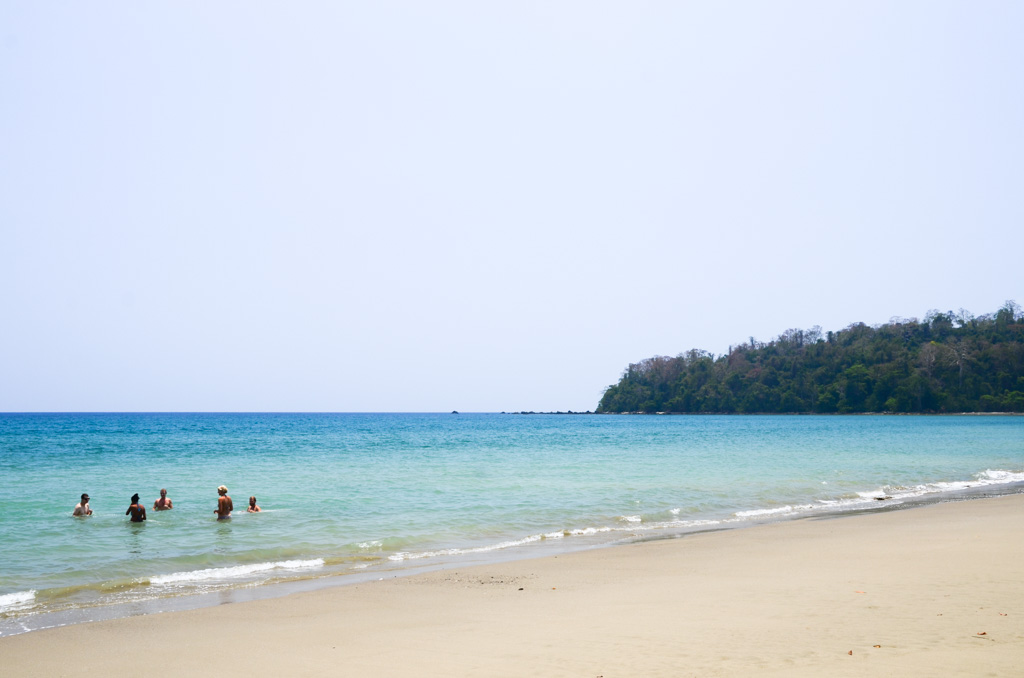
But first, a stop at the nice (but not memorable) Ramnagar Beach.
We needed some courage for our hunt, and picked up some “strong” (boozy) 650ml bottles of Haywards 5000 prior. It purports to be beer.
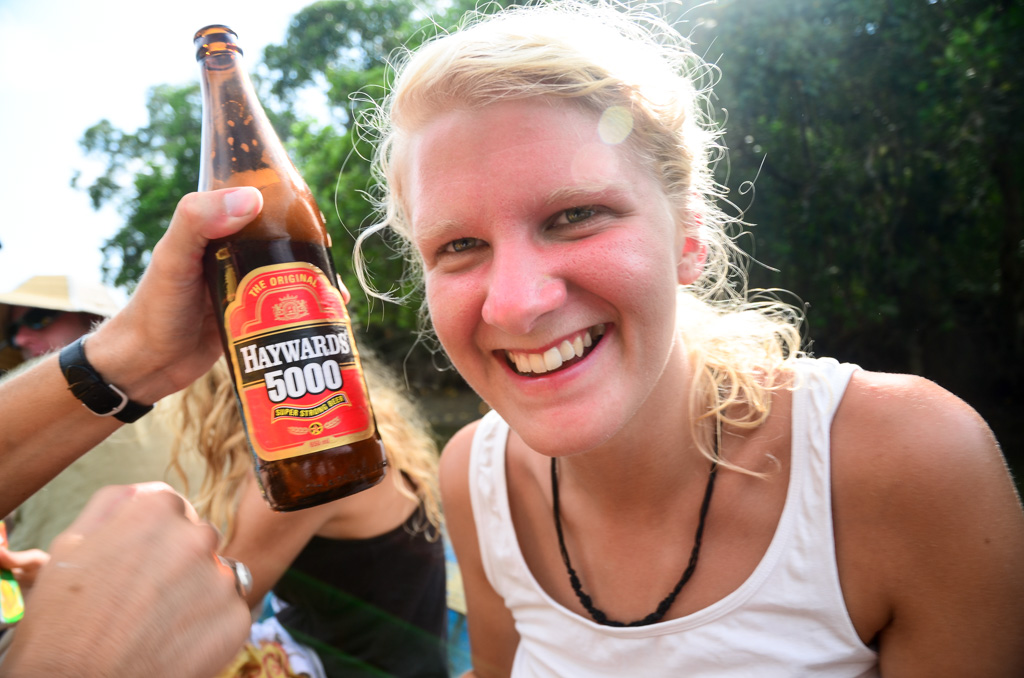
Sara. happy hunting.
The diesel engine of the dunghi was, as usual, deafening, and we saw next to nothing other than the bottom of our brown bottles. and thick green mangroves that covered the shores.
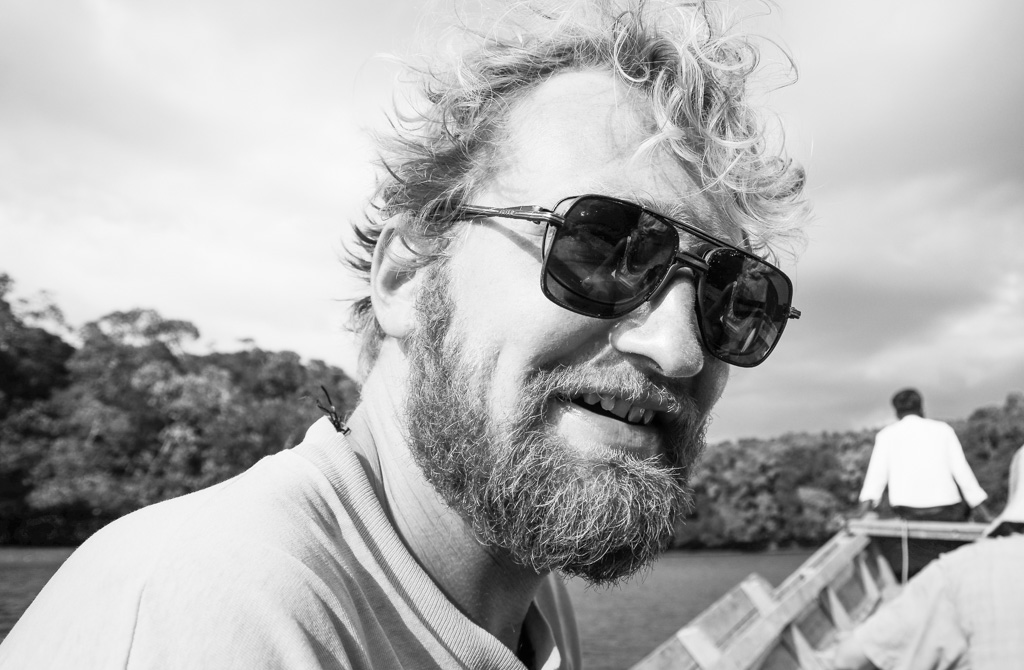
When Indian touts asked Christian the ever-looping question of “SIR, WHICH COUNTRY?” he responded with a firm (and false) “PAKISTAAAAAN”, which quickly changed the topic of conversation. “NO, SIR – BAD COUNTRY, BAAAAD COUNTRY.”
The boat boys weren’t REALLY looking for crocodiles. They were just toting around some westerners until the clock ran out. Something had to be done – Christian jumped up and insisted that the engine be killed – the throbbing of the motor was probably driving away the wildlife. He stood and poled us into a shallow mangrove, where we hit bottom and his credibility as a crocodile stalker was stripped. Stealth-mode came to an end and we were back to our noisy clip.

Attempted heroics by Christian.
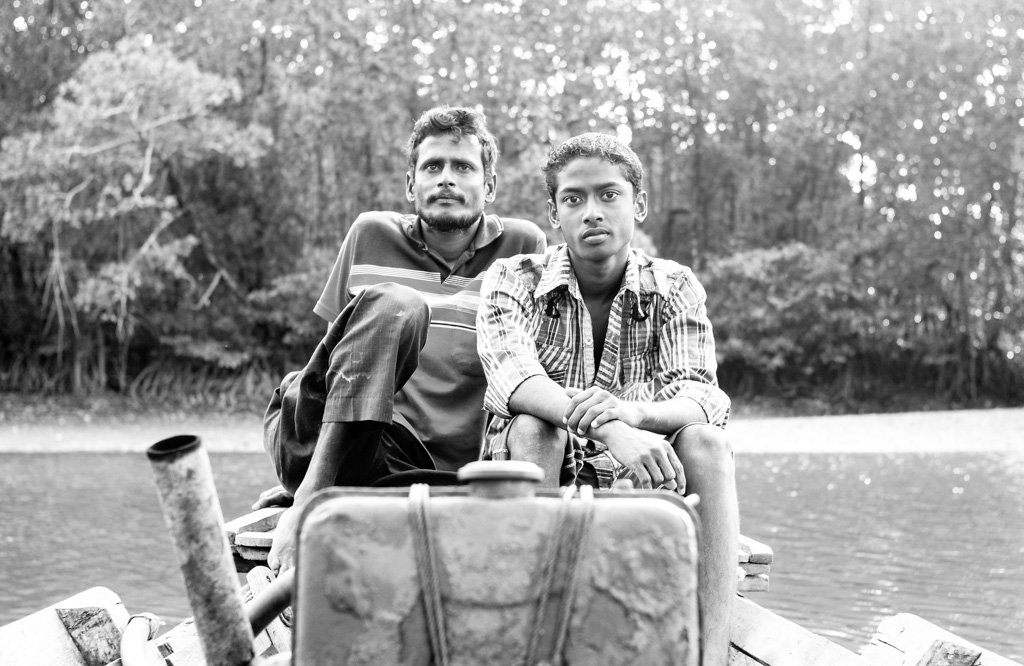
our captain and his assist.
For as much talk as there has been of salt water crocodiles in the Andamans, I still haven’t seen one. Not one, despite that they are the largest living reptile on earth! I suppose they’re one of those things that you see when you’d least like. We tried so hard!
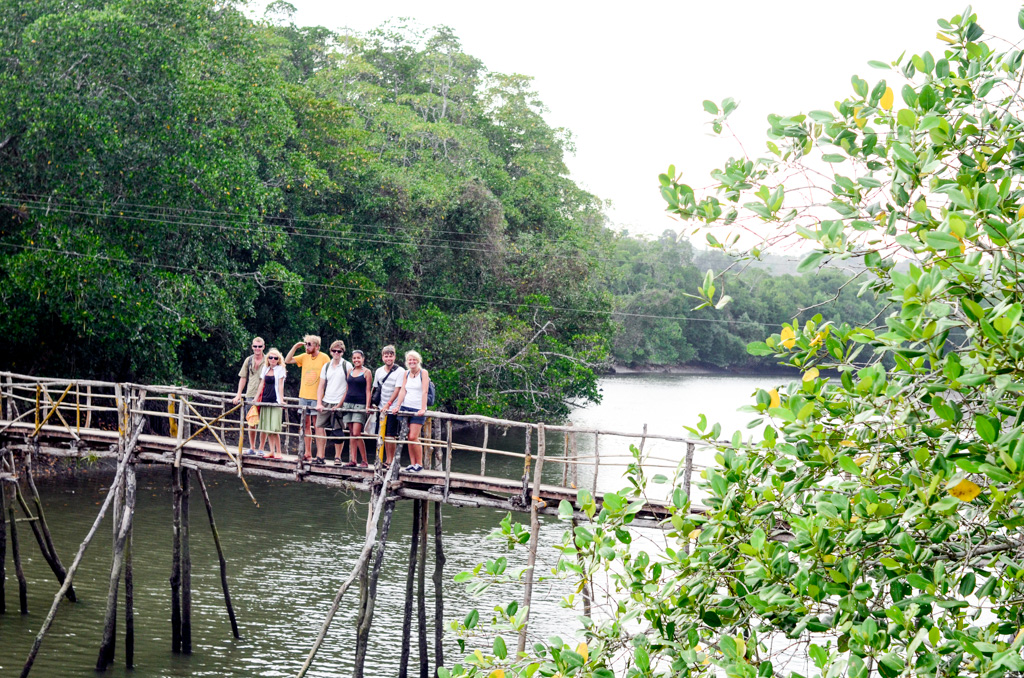
One of us hadn’t given up hope just yet.
After playing in the wilds of North Andaman for five-or-so days, it was once again time to move on. I battled my way through booking an airline ticket in Diglipur (for transit from Port Blair to Delhi), which took hours and cost a lot more than I would have hoped. I can’t say I was surprised by this – as usual, trying to accomplish what would be a routine task at home took on a whole new character in India.
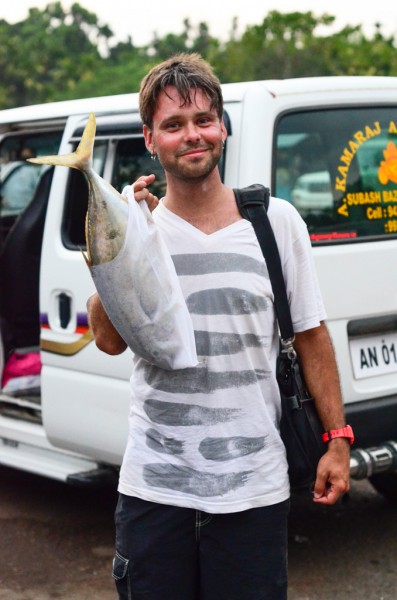
This was the only monster I found in North Andaman, and for 200 Rupees ONLY! Diglipur.

Diglipur fish market
I managed ground transpo too: “Uncle” finagled me a seat on the 12-hour bus from Aerial Bay Jetty to Port Blair.
“I get you seat number four – very good seat,” he smiled/winked. I had a strange feeling I was in for trouble, or at least discomfort.
The bus left at 4:00 AM, and Bernard/Naella were on it with me. The tea shop outside of Aerial Bay Jetty was just opening when we got there, replete with chai for miles and all the horrible processed/packaged snacks of any Indian outpost.

CRAZY SNACK harnesses all the flavor of a slightly sweet saltine. And lucky you, 33% more, free!
Seat number three and four already had two people in them – a woman, probably in her late thirties, and her 10-12 year old son. I showed her my ticket and got a confused look in return. Was I in the wrong place? Were they? No, the seats were clearly numbered. I sighed and pressed myself into the two seats, split betwixt the three of us.
Thanks to the lack of available space, my hip and right shoulder hung into the aisle. Aisle space was also at a premium, so the ever-pacing bus captain routinely ran into me at full force each time he passed, which also happened to be each time I had almost managed a nap due to the heat and monotony.
Thanks, “Uncle”, for the very good seat!

I shouldn’t complain too much. The goats had the worst seats – in the dark dungeon-like hold of the bus! Here they are, serving the first part of their 12-hour sentence. The only plus of being imprisoned below: they didn’t have to listen to the eardrum-destroyingly-loud Bollywood music that the rest of us endured the entire time (and no one was dancing or singing along, mind you). The bus captain smiled like he was doing us a favor every time he flipped on the power amp to bomb us with another saccharine-sweet pop song. Not pictured: a roof full of chickens. (photo by Bernard)

Oh, there you are, rooftop chickens. Crossing from Middle Andaman to South Andaman by ferry. Oh, and just because you’ve already paid your bus fare, you’re not immune to an additional ferry toll. I think it was six Rupees.
Once the bus crosses south from Middle Andaman to South Andaman, things change a bit – the road weaves through a restricted tribal area.
The ATR (Andaman Trunk Road) cuts directly through tribal reserves for the Jarawa tribe, who are still living as they did thousands of years ago (aside from their interaction with the modern world of passing cars and buses). Travelers and commuters are instructed not to take photos, communicate with the Jarawa if they see them, or to give them any food or trinkets. Word is that the tribe has been coming out of the forest to take handouts from buses, and this has been eating away at their self-reliance. The number of Jarawa left in the Andamans is estimated at 250-400 individuals.
The ATR remains defiantly open despite a Supreme Court order in 2002 that the road be shut. Complaints include that the interaction of the outside world with the Jarawa has led to spread of disease throughout the tribe and irreversibly damaged their culture.
In January 2012, video surfaced of Jarawa women being forced to dance for tourists in exchange for food, prompting outrage and further analysis of whether the ATR should remain open or not. The discussion is ongoing.
Bernard, Naella, myself, the goats and the chickens arrived in Port Blair around 4:00 PM, never having seen a Jarawa, and never needing to hear another Bollywood song for the rest of our lives. We got rooms, got dinner, and went down for the night.
I awoke on March 25th with one full day to kill in Port Blair before my flight back to the Indian mainland. What else to do but head to another pretty beach for snorkeling? I had successfully avoided museums and important historic sites for weeks now – why not continue the streak?
That morning, the bus to Chidya Tapu, at the southernmost tip of South Andaman, departed 15 minutes before it was scheduled (This makes no sense, and is OH SO FRUSTRATING!), so we paid way too much for a rickshaw for passage to said beach.
It was remote and quite nice, other than one haunting thing – the signage:

Chidya Tapu. Let’s go swimming?
We still weren’t done with beastly saltwater crocodiles? Were these signs just legal precautions after the 2010 incident of an American woman being killed by a crocodile off a beach in Havelock?
After some nervous laughter, we put on our snorkeling gear and swam out to the reef. It was quite nice, with a range of life.

Bernard and Naella brought a waterproof camera.

banded sea krait – only one of the world’s most venomous/deadly snakes.

Me!

Us! If you must know, we still didn’t see any crocodiles. Big zero.
I’m not making light of the multiple deaths that have occurred in the Andamans via saltwater crocodile. I have a healthy fear for the things, and have exercised a certain amount of judgment when getting in the water. That said, things do still happen. Two crocodile-related deaths have been reported in the two months since my time in the Andamans, one as recent as April 12th in Hut Bay. If you’re going to swim in the Andamans, avoid doing so near mangroves, where crocodiles tend to hide. Beaches like Havelock’s Beach No. 7 are still not 100% safe, either – even though they aren’t the natural, preferred habitat of the crocs. Unfortunately, I can’t offer any comfort on the topic – it’s kind of a swim-at-your-own-risk type of deal!
The next morning, I headed to Port Blair’s airport for the Indian airport security shuffle. Think the TSA is bad in the US? Ha! After enduring the redundant, ineffective nonsense of the multiple checks, I boarded my plane for Delhi, by way of Kolkata.
Wow, my 24 nights in the Andamans had been unforgettable. Such a breadth of experience, and such close interaction with such a high quality of traveler. There was a time in my India trip in which I thought I might not get to the Andamans. This holiday-within-a-holiday was a “gold star A+” event, not a mission-critical one. But I find that looking back on my trip, this place was beyond just a bunch of beautiful beaches and wildlife – it encompassed some of the best days I’ve had to date. The people, the weather, the place itself, the food (and the prices of it all, too) – everything was right.
There were a few places I didn’t make it to that got rave reviews from friends and from the Lonely Planet, listed below:
- Little Andaman (take the ferry from Port Blair to Hut Bay)
- Long Island (ferry from Havelock to Long Island)
- Ross & Smith Islands (day trip from Aerial Bay Jetty, near Kalipur)
- Mahatma Ghandi Marine National Park / Wandoor (near Port Blair)
Part of me rebelled at the thought of leaving the Andamans before I was forced to. I could have put in another 20 days there with an extended permit! But my India trip wasn’t of indefinite length, and I still wanted to see a bit more of northern India. So off to Delhi I went to carry on, leaving behind my blue water and white sand for the congestion, pollution, poverty and burning trash of the big city. Good trade, no?
Next up: Back to Delhi, and Agra gets a second chance

goodbye to the Andamans, one of my favorite places ever!









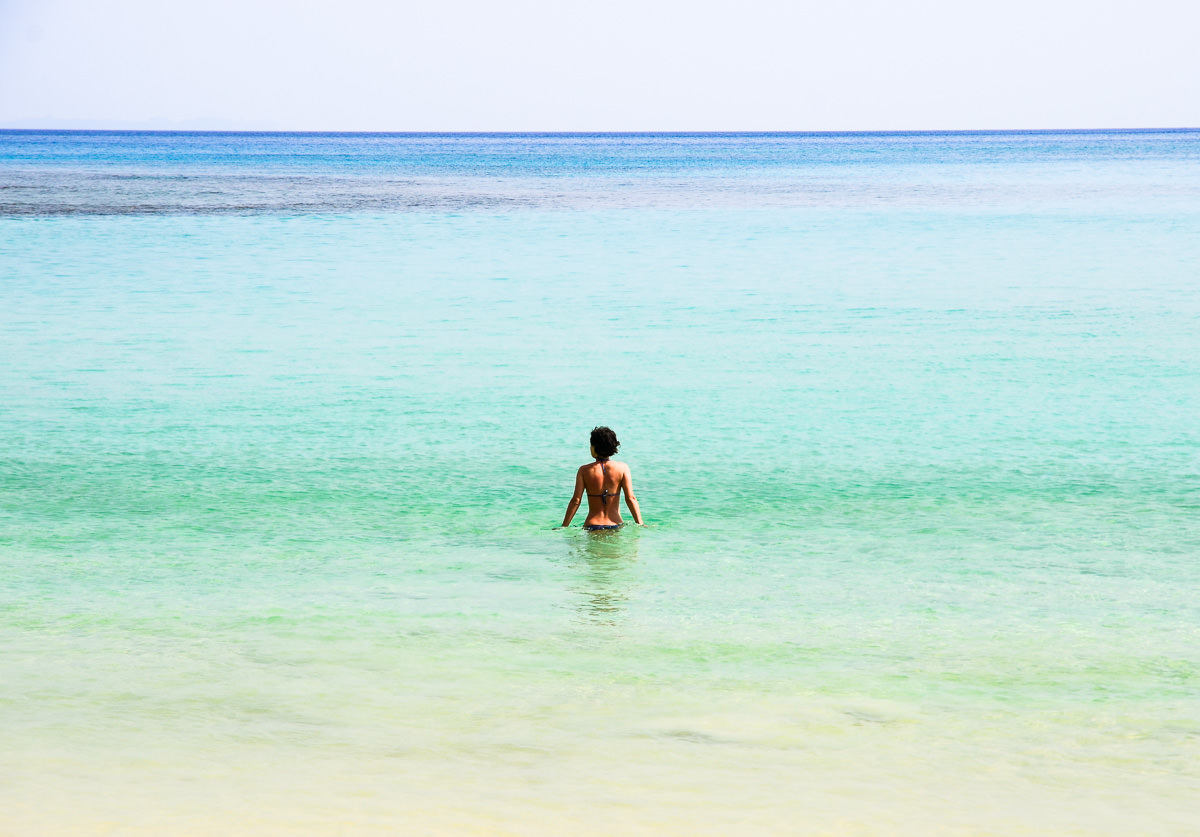
I went there exactly a month before you and to be true you have mentioned about everything very correctly – specially about the ticketing thing…faced a huge issue myself!!
Scuba driving in havelock was great fun. I did that around the lighthouse area in havelock.
I have not taken a ride up the saddle peak – out of time u know 🙁
Have you been to jolly buoy? snorkeling there is worth everything! That place is just toooooooooooooooooooooooooo beautiful…..i will never forget that
I’m not as mad at the government ferry ticketing office anymore, not because they exhibited any sort of newfound efficiency (they certainly did not), but rather, because their unexplained inability to issue me a ticket from Port Blair to Little Andaman led to my trip to Havelock, which (in so many words) landed me in Finland this July.
I don’t mean to get too “a butterfly flaps its wings” on you, but maybe there’s some sort of super-annoying cosmic predestination going on at Phoenix Bay Jetty. Then again, probably not!
My three favorite sites for diving off Havelock were: Johnny’s, Dixon’s, and Jackson’s. They’re deep-water sites though, so you’ll need certification to 30m depth. Good diving, though!
I didn’t make it to Jolly Buoy but heard good things. Sometimes it’s so hard to decide where to do your diving/snorkling/beaching. Everywhere you turn, someone has a rave review for a new place! I get a terrible fear-of-missing-out about such things, and have to just buckle down into one or two places and ignore the fact that I might be overlooking others. Only so much time!